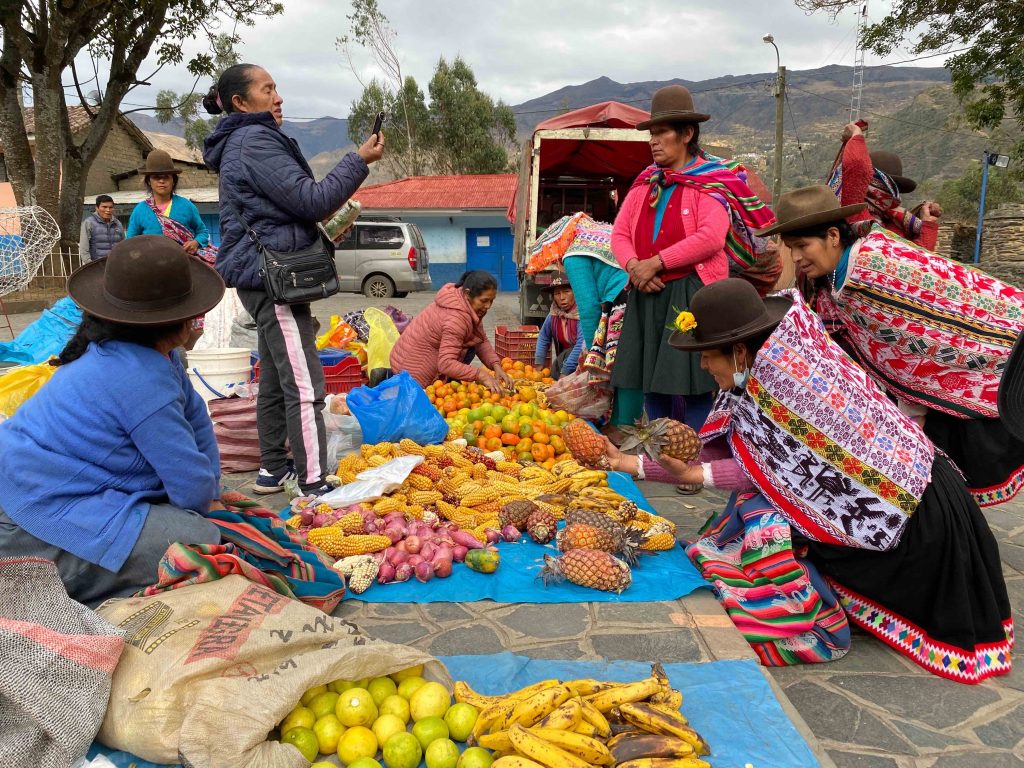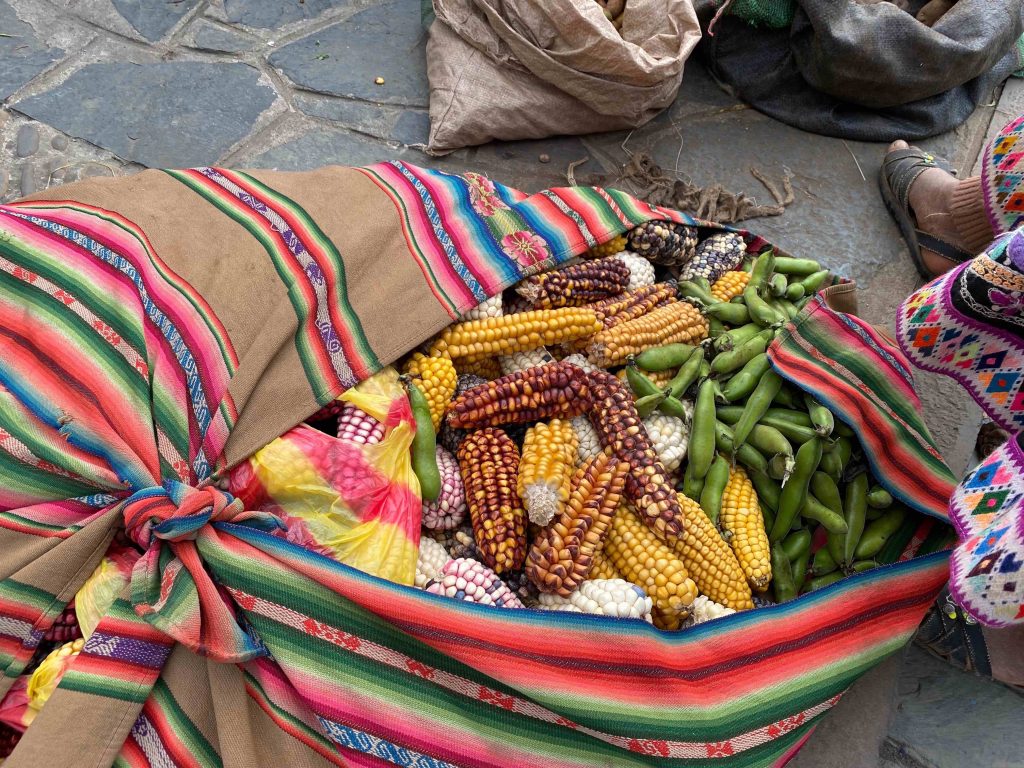The practice of chalay (or chhalay) embodies the Andean concept and value of reciprocity. It represents an ancestral alternative economic system which values, people, land and the sacred nature of food. Reciprocity is found at the heart of all relations, such that there are exchanges between people and mother earth, the apus (sacred mountains), plants and animals.
Historically in the Andes, non-monetary exchange has been linked to the ideals of economic and ecological complementarity, and contributed to self-sufficiency, not to economic gain. Although Andean farmers are now integrated into modern monetary economic relations, chalay continues to provide access to important goods and services without money. The farmers who practice chalay exchange foods, calculating the value of the products. In this case, value is not equivalent to the monetary value; rather it considers the time and effort for production, transportation, and takes into account the social relations between those doing the bartering, and the needs of the participants. The exchanges strengthen the relationships between family members and friends from different agricultural zones. Foods and seeds are also members of the family. When seeds are exchanged, the new seeds become ‘daughter-in-laws’. These new family members need to be treated with great care and respect so they will produce well.
I make chalay with corn seed. For the paracay variety, I make chalay with other women from the Rosaspata community. For seeds of the qello uwina variety I make chalay with women from the Ccachin communities. When I do chalay and exchange information on how to raise the seeds, we adopt them into our family, this helps the seeds from other places to adapt well to the land of my community, so we get a good harvest of corn.
Basilia Quispe Fernández
People who live in the middle zone, where there is maize, wheat and beans and there is little potato production, desire the delicious potato from the higher zones, as well as chuño and moraya (two kinds of freeze-dried potato). Those from the high zones desire the rich diversity of maize from the middle zone. From these two zones, they can also exchange for aromatic plants, fruits and vegetables from the valley. In this way, the families of the three zones exchange their products to diversify and balance their daily diet, and improve the nutrition of their children.
Chalay respects the sacred nature of food. Maize and potato are the source of life. They are for food, to sell, to trade for other products, to work in the fields. When taking the seeds to the market or another place, they smoke them in ritual, calling on Pachamama, asking her not to take the spirit of the plants, asking for them to remain in the community. When bringing new seeds into the home, offerings of coca leaves are made and they are sprinkled with chicha to welcome the seeds to their new home. Exchange in chalay is seen as an important part of the life journeys of the seeds.
Our Apu, sacred mountain, is the snow-capped Ccolque Cruz, with whom we do chalay in the month of August, which is carnival for our animals, for the cow, alpaca, llama. We make an offering to the Apu as a chalay, to help take care of our animals, so that they do not get sick. These times a disease has appeared that is killing our animals. Before we had more animals in this sector of Mapaccocha, many alpacas, llama sheep, and wild species such as llullucha (edible bacteria), now there is little llullucha and fewer animals.
Saida Juares Mamani from the Mapaccocha sector
In the barter markets (Chalayplaza), people used to bring many different products, including dry alpaca meat, wool, leather, and ceramic or iron products, but the conditions are changing. Some products, like salt or sugar, are almost fully integrated into the monetary economy. Some resellers of food products participate in the barter markets and try to exploit or trick the farmers. In these cases, the exchange is no longer respectful or just.
ANDES and the indigenous communities of Lares recognize the importance of chalay, and are researching the evolution of the chalayplaza over the past 20 years. During the research, local community members expressed an interest in protecting and promoting the practice of chalay. In June 2021, a municipal ordinance was approved to recognize the importance of the barter markets:
“Declare the practice of ‘Chalay’ or Traditional Exchange of Crops and Seeds, which takes place in the market places of Hinopampa, C.C. Choquecancha, C.C. Q’achin and C.C. Huacahuasi, as an Expresion of the Immaterial Cultural Heritage of the District of Lares, which contributes to the conservation of agrobiodiversity and food security of the local population” .
Ordenanza Municipal No004-2021-MDL, Lares, 15 de junio del 2021
Another reflection of the interest in protecting the barter markets is a new collaboration between two Biocultural Heritage Territories, The Potato Park in Pisaq and The Chalakuy Maize Park in Lares. Members of the two parks, together with Asociacion ANDES, are working to preserve ancestral knowledge and practices related to the Andean landscape and food systems, including chalay.
I do chalay in the Choquecancha market, we’ve always done chalay here. I have been doing chalay since I was young. Chalay is very important to exchange food products, to balance our diet, you don’t use money and that helps my budget. I am very happy because now more people are coming to barter. Like the communities of the Potato Park, I want the chalay to be more frequent.
Simeona Huillca Betancurt
Full list of contributors
Asociacion ANDES
Tammy Stenner
Parque de la Papa
Jhon Ccoyo Ccana
Ricardina Pacco Ccapa
Aniceto Ccoyo Ccoyo
Nazario Quispe Amao
Lino Mamani Huarka
Mariano Sutta Apocusi
Ciprian Ccoyo Banda
Bacilides Jancco Palomino
Daniel Pacco Condori
Parque Chalakuy
Ricardo Pacco Chipa
Juan Víctor Oblitas Chasin
Alberto Condi Durian
Saida Juares Mamani
Alfredo Hancco Santacruz
Maritza Churata Ttito
Basilia Quispe Fernández
Simeona Huillca Betancurt

This work is licensed under a Creative Commons Attribution-NonCommercial-ShareAlike 4.0 International License.
Learn more
Seed drawings
Joan Gabie was commissioned by living-language-land to create a series of drawings based on seeds for their website. Her ink drawings of seeds and seed-bearing plants are intended to reflect the ethos of nurture and new growth.
“Seeds are like little worlds: contained within them the endless possibilities for life and newness.
Continue reading > “Seed drawings”





